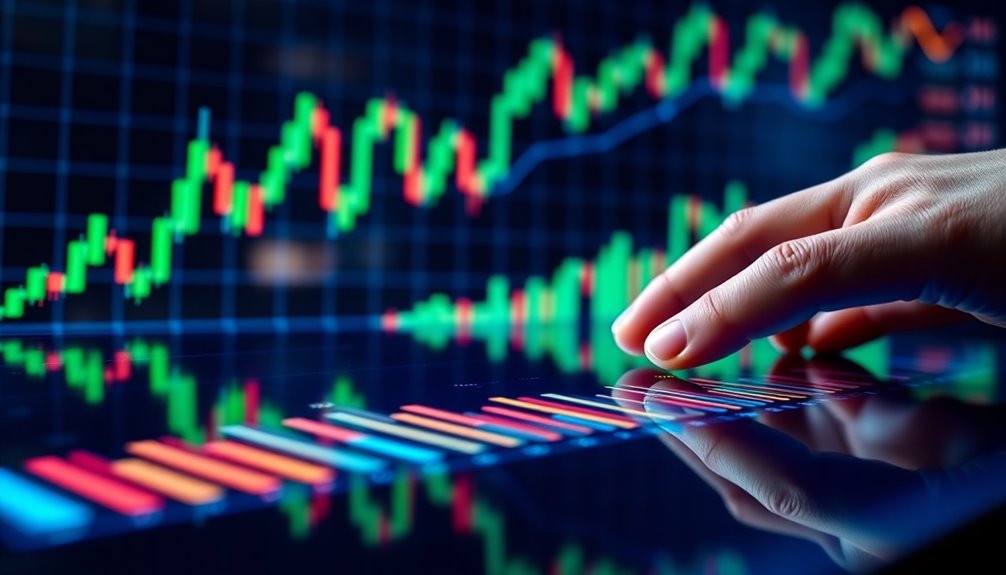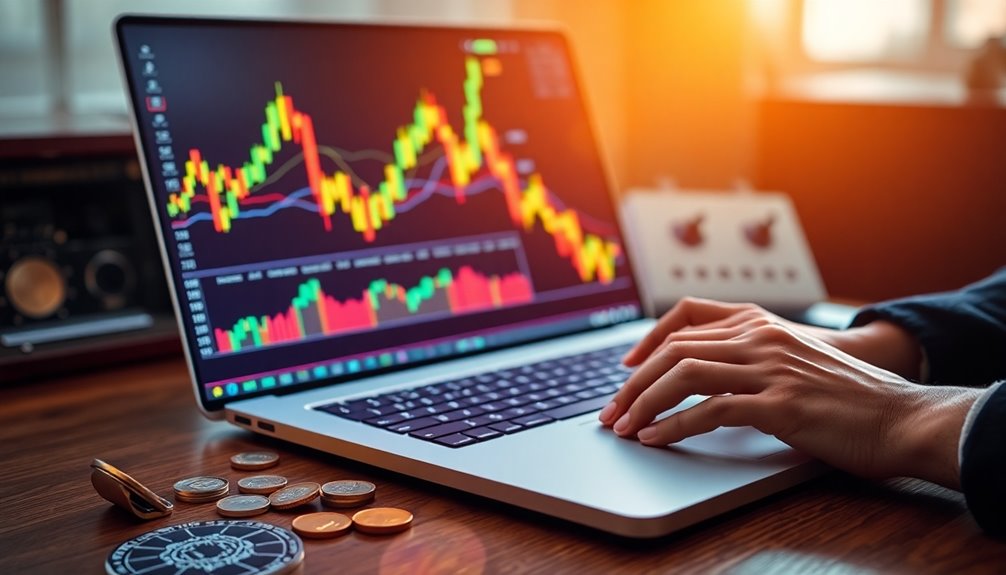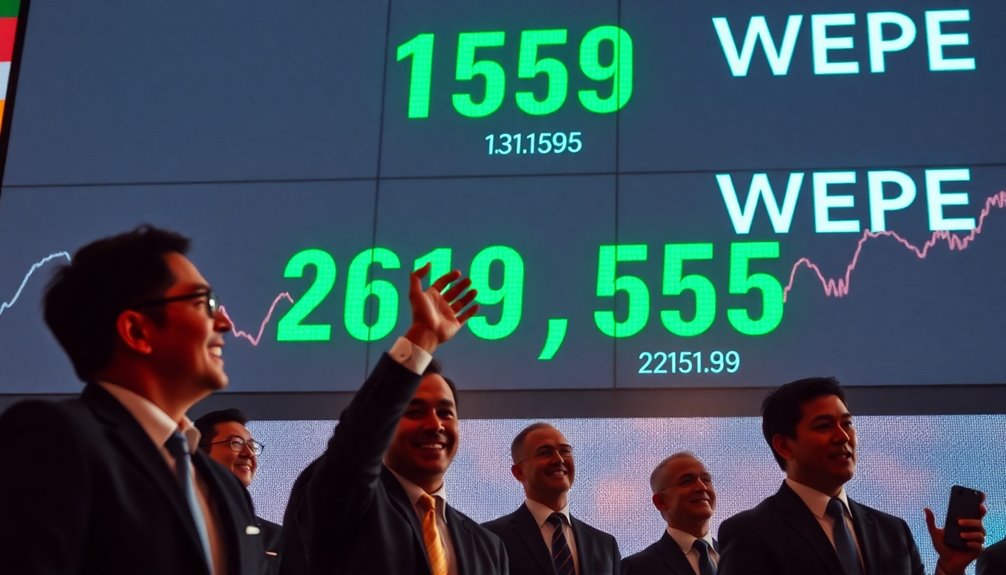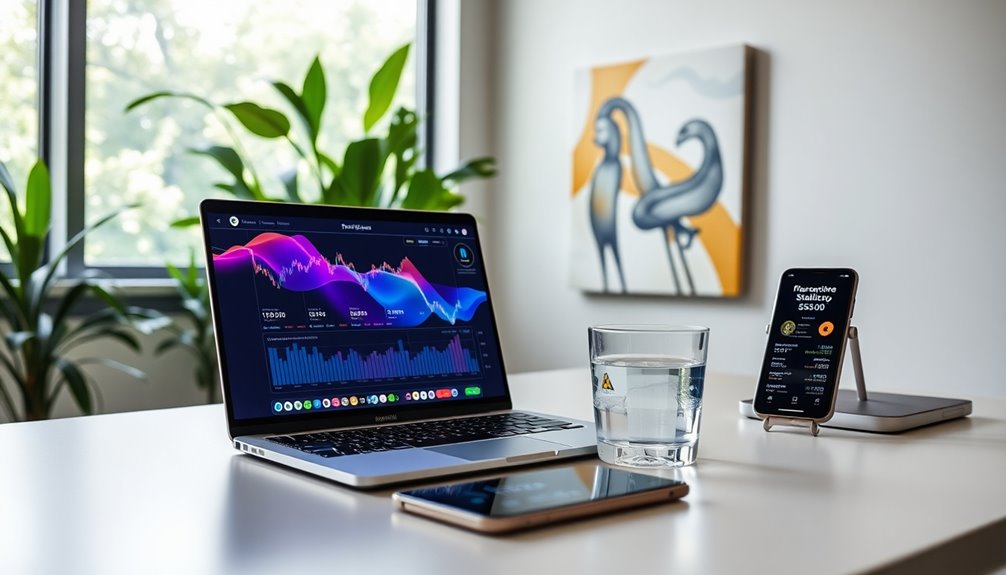Understanding cryptocurrency trading volume is essential for your trading success. Trading volume indicates market activity and reflects the level of interest from buyers and sellers. High volume usually leads to significant price movements and enhances liquidity, making transactions smoother. Conversely, low volume can signify lack of engagement, increasing volatility and risks of manipulation. Tools like On-Balance Volume can help you analyze market sentiment. By monitoring volume trends, you can develop more effective trading strategies and make informed decisions. Keep exploring to discover how volume impacts your trading approach and overall market dynamics.
Key Takeaways
- Trading volume measures the total cryptocurrency traded over a specific period, indicating market activity and sentiment.
- High trading volume improves liquidity, allowing for smoother transactions and reduced price manipulation risks.
- Volume spikes can signal significant price changes or market manipulation, making it crucial for traders to monitor.
- Tools like On-Balance Volume (OBV) help assess market pressure and the dynamics between buying and selling.
- Regulatory developments aim to enhance transparency and integrity in cryptocurrency trading volume reporting.
Volume as Market Activity Measure

Volume serves as a crucial indicator of market activity in cryptocurrency trading.
By measuring cryptocurrency trading volume over a 24-hour period, you can gauge market sentiment and liquidity. High trading volume often points to increased interest, with more buyers and sellers actively engaging, which can lead to notable price movements.
Using volume indicators like On-Balance Volume (OBV) and the Money Flow Index (MFI) helps you assess potential shifts in market sentiment. Sudden spikes in trading volume can precede significant price changes or even indicate market manipulation.
Understanding these volume dynamics is vital for crafting effective trading strategies, as high liquidity lowers the risk of price manipulation and contributes to overall market stability.
Market Activity Overview

Market activity in cryptocurrency reflects the dynamic interplay between buyers and sellers, shaping price movements and overall market sentiment.
Trading volume measures the total amount of a specific cryptocurrency traded over a defined period, often analyzed in 24-hour intervals. High trading volume generally indicates strong market participation, leading to significant price movements driven by increased demand or supply.
This volume serves as a critical volume indicator for assessing liquidity; greater volumes contribute to smoother trading experiences and reduce price manipulation risks. Additionally, understanding upcoming technological upgrades can further enhance the evaluation of trading volume's impact on market dynamics.
Volume Reflects Trader Engagement

Trader engagement often shines through in trading volume, revealing the level of interest in buying or selling a cryptocurrency. High volume typically indicates strong trader involvement, often leading to significant price movements.
For example, a surge in Bitcoin's trading volume can signal upcoming price increases, especially during market rallies when buying volume spikes alongside bullish trends. By analyzing volume over different timeframes—like daily or weekly—you can better understand ongoing market activity and sentiment, leading to more informed trading decisions.
Moreover, volume indicators, such as On-Balance Volume (OBV), provide insights into whether buying or selling pressure dominates the market.
On the flip side, low volume may suggest a lack of engagement, resulting in price stagnation or vulnerability to manipulation.
Pros and Cons of Trading

While diving into cryptocurrency trading can be exhilarating, it's essential to weigh both the pros and cons.
On the plus side, understanding crypto trading allows you to benefit from high trading volume, which indicates strong market interest and liquidity. This liquidity helps you execute large transactions with minimal price impact and can signal significant price movements.
However, low trading volume can lead to increased volatility and risks of market manipulation, making it crucial to monitor volume trends. Additionally, regulatory scrutiny on crypto exchanges has risen, as some inflate trading volume figures to attract buyers and sellers.
Volume Versus Price Correlation

Understanding the relationship between volume and price is vital for making informed decisions in cryptocurrency trading.
Trading volume often acts as a key indicator of market interest, especially when significant increases in volume precede notable price movements. For investors, a positive correlation between volume and price typically indicates a strong trend, with high trading volume signaling robust buying pressure.
Conversely, if prices rise while volume declines, it may suggest a weakening trend and a potential price reversal. Analyzing volume alongside price movements allows you to identify divergences, helping you gauge whether to expect continuations or reversals.
Market Manipulation Concerns

As the cryptocurrency market grows, concerns about market manipulation have become increasingly prominent. Over 50% of Bitcoin trades were flagged as fraudulent, mainly due to deceptive practices like wash trading. This highlights serious issues surrounding reported crypto trading volumes.
Automated trading programs and bots often inflate volume traded, distorting genuine trading activity and misleading investors. With regulatory scrutiny ramping up, as seen with the SEC's recent charges against various entities, the need for transparency is urgent.
Data aggregators like CoinMarketCap are stepping up to combat fake transactions, aiming to restore market integrity. However, the rise of AI in trading adds complexity, presenting both opportunities for analysis and risks of further manipulation in reported trading volumes.
Emerging Regulatory Frameworks

With the rapid evolution of cryptocurrency markets, regulatory bodies are stepping up to create frameworks that ensure investor protection and market integrity.
The EU's Markets in Crypto-Assets (MiCA) regulation aims to enhance transparency and stability in crypto trading volume. Additionally, the SEC's recent actions against market manipulation signal increased scrutiny of cryptocurrency exchanges.
As you navigate this landscape, be aware that the U.S. Attorneys' Office has indicted numerous individuals for fraudulent practices, reflecting the urgency to protect investors.
Furthermore, the formation of the Data Alliance among data aggregators like CoinMarketCap enhances transparency in reporting trading volume, addressing concerns over fake transactions.
Ongoing discussions about AI's role in trading underscore the need for new rules to maintain fair practices in the market.
Volume-Based Entry Timing

In the dynamic world of cryptocurrency trading, timing your entry can significantly impact your success. To enhance your entry timing, focus on analyzing trading volume trends.
Look for volume spikes that coincide with breakout patterns; these increases in trading volume often signal strong market support for a price direction. The Money Flow Index (MFI) can help you identify overbought or oversold conditions, guiding your decisions on when to enter a trade.
Additionally, using On-Balance Volume (OBV) allows you to gauge buying and selling pressure, revealing potential entry points when OBV trends align with price movements.
Finally, keep an eye on trading volume alongside market news, as positive developments typically lead to increased volume and bullish price action.
Frequently Asked Questions
How to Understand Volume in Crypto?
To understand volume in crypto, you'll want to look at how many coins are traded within a specific timeframe, usually 24 hours.
High volume often indicates strong interest, which can signal potential price changes.
Pay attention to volume trends alongside price movements; discrepancies might hint at market reversals.
Utilize tools like On Balance Volume or the Money Flow Index to analyze these trends and gain insights into market dynamics.
Is High Trading Volume Good for Crypto?
High trading volume is generally good for crypto. It indicates increased market activity and investor interest, making it easier for you to execute trades without significantly impacting prices.
When trading volume is consistent, you can expect greater liquidity, reducing risks of price manipulation.
Plus, spikes in volume often signal important price movements, helping you make more informed decisions.
How Much Volume Is Good for Crypto?
When you're wondering how much volume is good for crypto, you're diving into a crucial aspect of trading.
Generally, a daily trading volume of over $1 million is solid for smaller coins, while established ones like Bitcoin often exceed $30 billion.
You'll want to look for consistency; volumes significantly above historical averages can signal strong investor interest and potential price movements, making it vital to your trading strategy.
How to Read Crypto Volume Charts?
To read crypto volume charts, start by looking at the volume bars, which show the amount traded over a specific period.
Green bars indicate price increases, while red bars signal price drops. Pay attention to spikes, as they often suggest significant market movements.
Combine this data with candlestick patterns for deeper insights.
Tools like On Balance Volume (OBV) and Volume Weighted Average Price (VWAP) can also help you analyze trading pressure and trends effectively.
Conclusion
In the world of cryptocurrency, trading volume is like the heartbeat of a bustling city; it tells you how alive the market is. Just as a vibrant marketplace attracts more vendors and shoppers, high trading volume signals strong trader engagement. But beware of shadows lurking in the alleys—market manipulation can distort this lively scene. As regulations emerge, navigating this dynamic landscape requires you to stay informed and agile, ensuring you make the most of your trading journey.









